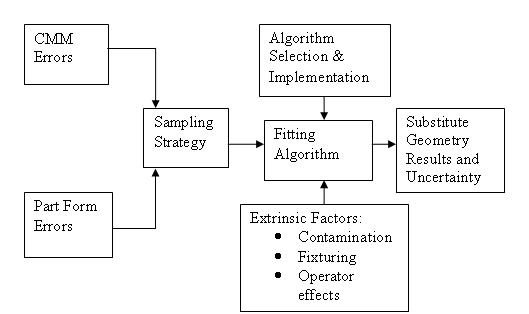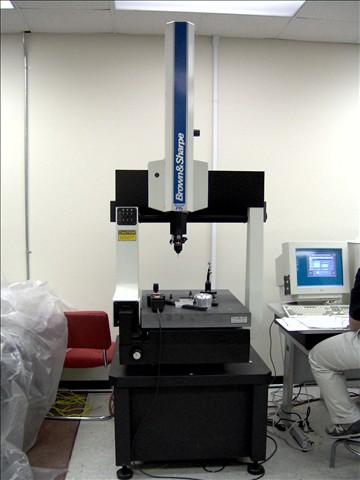Tolerance analysis
From DDL Wiki
| Line 5: | Line 5: | ||
As defined by Busch (1989), coordinate measuring machines (CMMs) locate coordinates on three dimensional structures while simultaneously integrating both the x-y plane and z-plane along with orthogonal relationships. CMMs then utilize a computer and companion software to analyze and interpret measurement results (Dhanish, 2002). | As defined by Busch (1989), coordinate measuring machines (CMMs) locate coordinates on three dimensional structures while simultaneously integrating both the x-y plane and z-plane along with orthogonal relationships. CMMs then utilize a computer and companion software to analyze and interpret measurement results (Dhanish, 2002). | ||
| + | |||
| + | [[Image:CMM.jpg]] | ||
CMMs use 3 axes in order to reach points on a three dimensional surface, with a probe on the third axis. The CMM calculates where a point is in space by reading the displacement of the probe in all the axes and calculating the mathematical offset of the diameter of the tip at every point (DEA 1995 a). | CMMs use 3 axes in order to reach points on a three dimensional surface, with a probe on the third axis. The CMM calculates where a point is in space by reading the displacement of the probe in all the axes and calculating the mathematical offset of the diameter of the tip at every point (DEA 1995 a). | ||
| Line 25: | Line 27: | ||
However, Phillips et al. (1998) points out that CMM hardware accumulates error in addition to the error of the object of interest. The researchers generated a schematic illustrating error aggregation in CMM measurement: | However, Phillips et al. (1998) points out that CMM hardware accumulates error in addition to the error of the object of interest. The researchers generated a schematic illustrating error aggregation in CMM measurement: | ||
| - | + | [[Image:CMM_Error.jpeg]] | |
Figure 1 Error aggregation in form verification process (Adapted from Busch 1989) | Figure 1 Error aggregation in form verification process (Adapted from Busch 1989) | ||
| - | + | ||
Figure 1 explains error aggregation that may occur during data collection. When evaluating sampling strategies, not only are part errors accumulated but also CMM errors, i.e. failure to calibrate the machine, axis displacement, machine repeatability, etc. Though sampling strategy is intended only to calculate part form error, CMM error is inadvertently calculated as well. The end result is an approximation that incorporates form and CMM errors that cannot be separated. | Figure 1 explains error aggregation that may occur during data collection. When evaluating sampling strategies, not only are part errors accumulated but also CMM errors, i.e. failure to calibrate the machine, axis displacement, machine repeatability, etc. Though sampling strategy is intended only to calculate part form error, CMM error is inadvertently calculated as well. The end result is an approximation that incorporates form and CMM errors that cannot be separated. | ||
Revision as of 13:27, 7 September 2007
Introduction
Coordinate Measuring Machine (CMM)
As defined by Busch (1989), coordinate measuring machines (CMMs) locate coordinates on three dimensional structures while simultaneously integrating both the x-y plane and z-plane along with orthogonal relationships. CMMs then utilize a computer and companion software to analyze and interpret measurement results (Dhanish, 2002).
CMMs use 3 axes in order to reach points on a three dimensional surface, with a probe on the third axis. The CMM calculates where a point is in space by reading the displacement of the probe in all the axes and calculating the mathematical offset of the diameter of the tip at every point (DEA 1995 a).
Busch (1989) states that such a device has several advantages in a quality-control setting when combined with certain criteria, such as:
1. Multiple features-when there are several geometric features being controlled 2. High unit cost-if destructive inspection is not viable, then a CMM is the less costly alternative
3. Production interruption-CMM inspection will not cause downtime in machining
Advantages
Limitations
However, Phillips et al. (1998) points out that CMM hardware accumulates error in addition to the error of the object of interest. The researchers generated a schematic illustrating error aggregation in CMM measurement:
 Figure 1 Error aggregation in form verification process (Adapted from Busch 1989)
Figure 1 Error aggregation in form verification process (Adapted from Busch 1989)
Figure 1 explains error aggregation that may occur during data collection. When evaluating sampling strategies, not only are part errors accumulated but also CMM errors, i.e. failure to calibrate the machine, axis displacement, machine repeatability, etc. Though sampling strategy is intended only to calculate part form error, CMM error is inadvertently calculated as well. The end result is an approximation that incorporates form and CMM errors that cannot be separated.
Sample Products

